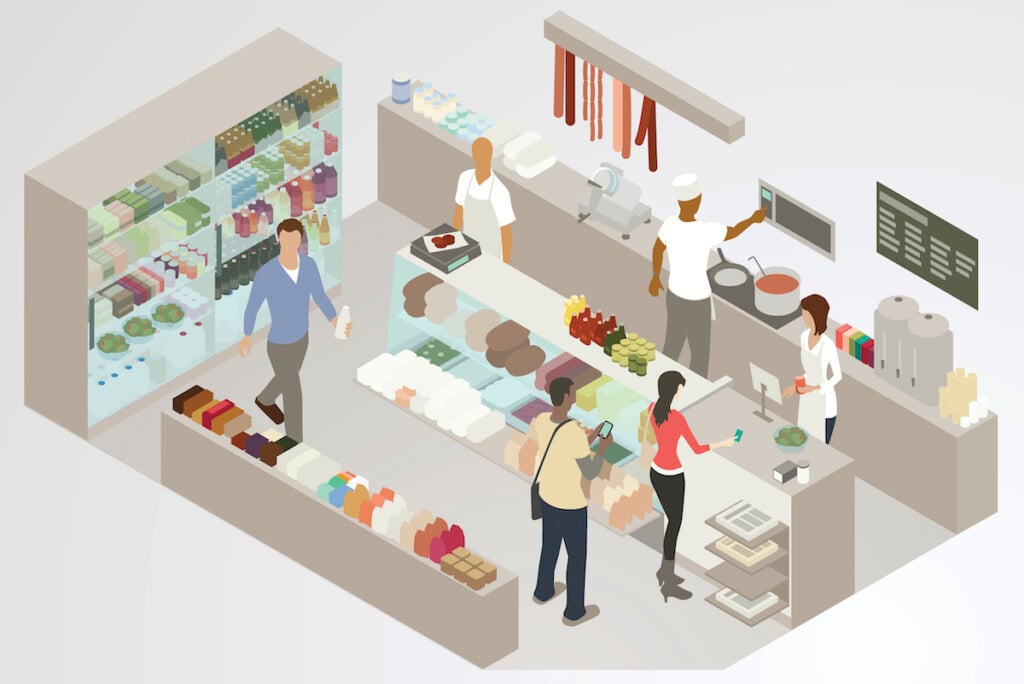The World Of Grab-N-Go
Convenience stores are proliferating in Bergen, selling the one or two items you want to pick up in a hurry. But, as one resident asks, “Do we really need so many?”

On a Sunday of drenching rain, the Wawa on Essex Street in Lodi is an oasis of light and bustle. Outside, cars line up for gas, while inside, customers are equally intent on refueling. A frazzled mom looks to assuage her restive brood with salty snacks, while a middle-aged man with serious bed head is taking deep draughts of his supersized coffee even before he’s paid for it. Three young men are waiting at the soup and sandwich bar for an early lunch or maybe a late breakfast. The scene is likely being repeated at the hundreds of Wawas, QuickCheks, 7-Elevens and independently owned convenience stores across Bergen County. Brick-and-mortar retail may be in decline overall, but convenience stores appear to be bucking the trend, especially in northern New Jersey.
In fact, according to the National Association of Convenience Stores (NACS), from 2009 to 2018, the number of convenience stores in the state rose 20 percent, from 2,695 to 3,229. Their number dipped slightly between 2018 and 2022, reflecting the dampening effect of the pandemic. But last year the stores began to rebound: Across the country, the number of grocery stores fell by 0.7 percent and drug stores by 1 percent, but the number of convenience stores was up 1.5 percent. Though there are no statistics specific to Bergen County, David Townes, managing director at the global real estate company JLL and a specialist in retail real estate throughout northern New Jersey, says convenience stores in the county “are thriving, and were, even through the uncertainty of the pandemic.”
Alana Friedman, a vice president at JLL, notes that in Bergen and elsewhere in northern New Jersey these stores are opening in malls, office buildings and even residential high-rises. And while landlords may balk at renting space to smoke shops, they’re rarely averse to leasing to convenience stores, even though those stores may also sell cannabis-related paraphernalia.
If you’ve never thought, “Gosh, I wish there were more spots in Bergen County selling lottery tickets, cigarettes and sweet, slushy drinks,” you’re not alone. Few of us long for another convenience store in the neighborhood, but given their proliferation, they must be filling a need. And according to Carol Rauscher, president of the North New Jersey Chamber of Commerce, the need is explained in the name: “The term ‘convenience’ sums it up,” she says, noting that in bad weather, for example, most of the stores go out of their way to offer ice melt and window scrapers. Rauscher herself frequents one or another of a series of convenience stores along River Road in Edgewater when she’s on her way home from work or the gym. “When I’m coming back from Pilates,” she says, “I stop at a convenience store for a cup of coffee, and maybe I buy a Powerball or Mega Millions ticket.” Like Rauscher, most of us chronically run short of one commodity above all—time—and convenience stores are designed with time-saving in mind.
“If I just need milk or eggs, I’ll stop at the 7-Eleven,” says Fair Lawn resident Lisa Lovermi. “I don’t go to the ShopRite for one or two items.”
CUSTOMIZED COFFEE
If you’ve been to a convenience store lately, you know that such stores sell more than milk and eggs. Want bagged ice, a flavored vape, a chili dog or some extra cash from the ATM? You’ll likely find it at any one of Bergen’s convenience stores. Gone are the days of the so-called mini-marts, which, in addition to everyday necessities, were famous for their no-frills, 50-cent cups of coffee. Today, at one of the convenience chains, that coffee will likely cost you at least twice as much and, at many of the stores, it’s available at a self-serve coffee bar offering a variety of brews, bean options and flavorings. 7-Eleven, for instance, advertises “3,000 ways to customize your coffee,” and plenty of convenience stores, such as the QuickChek on South River Street in Hackensack, offer lattes and frozen cappuccinos—though Hackensack resident Gigi Hudson prefers hers without the bells and whistles. She pops into a Wawa at least twice a week for a cup of coffee with milk and sugar and says she’s “very glad” the store is located on her regular route.
“If it weren’t here,” says Hudson, “I guess I’d have to make my own coffee”—a prospect she clearly doesn’t relish.
QuickChek also offers an ample selection of salads, wraps, sourdough melts and freshly made hoagies. And earlier this year, to the delight of its fans, Wawa rolled out pizza, which aficionados say is at least as good as the pies served at chains like Domino’s and Little Caesar’s.
“Food service has really grown,” says Jeff Lenard of NACS, who notes that 36 percent of the stores’ profits derive from food and beverages prepared on-site. “Convenience stores evolve as the customer redefines ‘convenience,’” he adds. In 2018, QuickChek opened its first “millennial-friendly” store at Hackensack Avenue and University Plaza Drive in Hackensack. It was designed to draw in younger, hipper customers, with free WiFi, charging stations, indoor and outdoor seating for 20 and a large selection of freshly prepared food items, including the offerings at a stand-alone soup bar.
Willie W., who didn’t want his last name published but said he was from “South Philly,” was at that soup bar recently, looking for a light lunch. The 20-something often visits the store on his way to see his cousin in Rochelle Park and usually treats himself to soup and a hoagie, but “I’ve been putting on weight,” he says. He’s a Wawa stalwart, like many from Pennsylvania, where the chain originated. Of all the convenience store chains, Wawa may have the most ardent fans, some of whom have etched their love onto their bodies in the form of Wawa goose-logo tattoos. Beryl Fein, who lives in a section of Hackensack that lacks a Wawa, says she hasn’t been to a convenience store in several years and is just fine with that. “But if there was a Wawa nearby, I’d definitely go there,” she says. She was trained for her current job as a corporate travel agent in Pennsylvania, and her hotel was down the block from a Wawa. “They have great stuff,” she says, waxing nostalgic. “Their flavored coffee is a lot cheaper than Dunkin’, and their sandwiches and salads are really, really good.”
A NEW DEFINITION
As convenience stores—or C-stores, as they’re sometimes called—redefine themselves to meet customers’ needs, it may be hard to distinguish them from other retail outlets. According to NACS, to be called a convenience store, a retail operation must provide easy access, either by car or foot; extended hours of operation and offerings that include at least some of what the trade organization calls “representative items” such as ketchup and pet food. “But the short answer,” says Lenard, “is that a convenience store is whatever people call convenience, and if you’re not convenient, you’re not a convenience store.”
THE BIG DRAWS
Like any retail enterprise, these small shops need to attract customers, and food prepared on-site has become a magnet for younger shoppers. More traditional draws continue to be tobacco products and fuel. According to NACS, the former represents the stores’ largest source of sales dollars, in part because tobacco products are so expensive. The potential income from controversial habits has also enticed some of the stores to break the law. In April, for instance, six Teaneck convenience store owners were charged with selling vape products to minors.
Another customer attraction is lottery tickets, though some stores won’t sell them because of the long lines that often accompany big jackpots, lines that can deter regular customers. “When you’re selling convenience, those lines make it more difficult for that customer looking to simply get a cup of coffee to get in and out of the store quickly,” says Lenard. On the other hand, the lines allow the stores to showcase their expanded offerings to new customers who may not have realized that they could pick up a salad and a smoothie with their scratch-offs.
One of the biggest enticements to shop convenience is gasoline. Across the country, nearly 80 percent of C-stores also sell fuel, cognizant that, after gassing up, customers are likely to stop in for a drink or a snack—or both. (That’s even more likely with EV charging stations, since it currently takes more time to charge an electric vehicle than to fill a tank with gas; currently, you can only charge your EV at a handful of convenience stores in the state, but that’s likely to change as the market for electric vehicles continues to grow.) Jack Ricci, a limo driver who stops at a Wawa or 7-Eleven three times a day to refuel, also inevitably buys at least one cup of coffee, and sometimes a sandwich. Born in Italy, he finds the coffee “too weak—like water,” he says, but he appreciates the hard-working staff at all the stores.
The percentage of stores selling fuel is a little lower in New Jersey, where drivers can’t pump their own gas, necessitating the hiring of more employees. Currently, some 45 percent of the state’s convenience stores sell fuel, but that number is likely growing. Townes notes that potential convenience-store owners looking for sites in Bergen increasingly want to open free-standing stores with gas stations attached.
TOO MUCH CONVENIENCE?
As new stores continue to roll out throughout the county, some residents are scratching their heads. Diane Palmer of Maywood, for instance, wouldn’t complain if a QuickChek or Wawa were to open nearby, but, she says, “You drive along the highways here and all you see are fast food, gas stations and convenience stores—do we really need so many?” In fact, some municipalities are asking the same question, worried, among other things, about potential traffic snarls. This spring, for example, the Paramus planning board held up approval for a new convenience store in town until the board’s concerns about traffic could be addressed.
Lenard notes, however, that most C-stores don’t create traffic tie-ups because of the way they’re usually sited, especially in suburban areas. Again, it comes down to convenience. Owners know that potential customers don’t want to make left-hand turns off the highway if they don’t have to, so the owners choose locations along well-traveled routes that entail only right-hand turns—and right-hand turns are far less likely to disrupt the flow of traffic. (That’s why it’s common to see two convenience stores, sometimes belonging to the same chain, virtually across the highway from each other.)
Another thing some people consider a downside of the stores, which stay open late and often hold large amounts of cash, is their reputation as a magnet for crime. According to FBI data, convenience stores are, in fact, the country’s fourth most common location of violent crime. In August of 2022, for instance, a gang of robbers held up five C-stores in Bergen County, all in the pre-dawn hours. And earlier this year, a man was arrested for robbing three of the stores—in Fair Lawn, Paramus and Mahwah—at gunpoint.
The Bergen residents we spoke with for this article, however, don’t seem overly worried about their safety in a convenience store. “Honestly,” says Lovermi, “I can’t think of a single negative thing about the 7-Eleven I go to. It’s on a well-traveled street around the block from my house, and I pass it practically any time I go anywhere. I’m glad it’s there when I need it.” In an on-the-go world, it seems, convenience rules.

